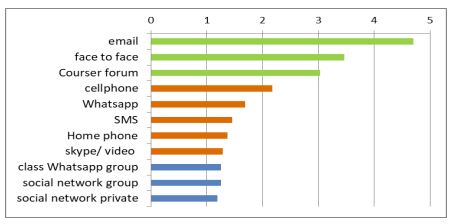
Communication is a cornerstone of effective teaching and learning in higher education. As educational institutions embrace diverse methods of instruction, understanding how students prefer to communicate is essential for creating an inclusive and engaging learning environment. This article explores the various channels of communication in higher education, delving into students’ preferences and offering insights into optimizing communication strategies for academic success.
1. Traditional Face-to-Face Interaction:
Importance:
- Personal Connection: Face-to-face interactions create a personal connection between students and educators.
- Real-Time Engagement: Immediate feedback and real-time engagement foster a dynamic learning environment.
Communicate Preferences:
- Beneficial for Complex Topics: Students often prefer face-to-face communication for complex topics that may require in-depth discussions.
- Classroom Settings: Lectures, seminars, and in-person meetings remain integral components of higher education.
2. Email Communication:
Importance:
- Formal Correspondence: Email serves as a formal communication channel between students and educators.
- Documented Communication: Important announcements, assignments, and feedback are documented for future reference.
Communicate Preferences:
- Information Dissemination: Students appreciate emails for timely information dissemination, including course updates and administrative matters.
- Structured Communication: Formality and structure make email communication suitable for official announcements and detailed instructions.
3. Learning Management Systems (LMS):
Importance:
- Centralized Platform: LMS platforms like Canvas or Moodle serve as centralized hubs for course materials, assignments, and discussions.
- Accessibility: Students can access resources and communicate with peers and instructors in a unified online environment.
Communicate Preferences:
- Convenience: LMS platforms offer convenience in accessing course materials, submitting assignments, and participating in discussions.
- Structured Communication: Discussion forums within LMS platforms facilitate structured and topic-specific communication.
4. Virtual Meetings and Webinars:
Importance:
- Remote Collaboration: Virtual meetings and webinars enable remote collaboration among students and educators.
- Guest Lectures: Inviting guest speakers for virtual sessions enhances exposure to diverse perspectives.
Communicate Preferences:
- Flexibility: Students appreciate the flexibility of attending virtual meetings, especially those balancing work or family commitments.
- Interactive Learning: Webinars with interactive elements, such as Q&A sessions, enhance engagement.
5. Social Media and Messaging Apps:
Importance:
- Informal Interaction: Social media and messaging apps provide informal channels for communication.
- Quick Updates: Instant messaging facilitates quick updates and notifications.
Communicate Preferences:
- Group Collaboration: Students may prefer platforms like WhatsApp or Slack to collaborate on projects or study groups.
- Accessibility: Quick and accessible communication fosters real-time interaction for immediate queries.
6. Office Hours and Consultation Sessions:
Importance:
- Individual Support: Office hours offer dedicated time for one-on-one interaction between students and educators.
- Clarifying Doubts: Consultation sessions provide a platform for students to clarify doubts and seek personalized guidance.
Communicate Preferences:
- Personalized Assistance: Students value the opportunity to receive personalized assistance during office hours.
- Feedback: Consultation sessions are ideal for discussing feedback on assignments and receiving guidance on academic progress.
7. Collaborative Online Platforms:
Importance:
- Group Projects: Collaborative platforms like Google Workspace or Microsoft Teams facilitate teamwork on group projects.
- Document Sharing: Seamless document sharing enhances collaboration on assignments and presentations.
Communicate Preferences:
- Efficient Collaboration: Students appreciate collaborative platforms for efficient teamwork, allowing real-time contributions and edits.
- Centralized Resources: Having a centralized platform for document storage and collaboration streamlines group project management.
8. Feedback Mechanisms:
Importance:
- Assessment Improvement: Timely and constructive feedback is crucial for students to understand their strengths and areas for improvement.
- Continuous Evaluation: Regular feedback fosters a culture of continuous evaluation and improvement.
Communicate Preferences:
- Timely Responses: Students prefer timely feedback on assignments and assessments to aid their learning process.
- Constructive Critique: Constructive critique that highlights areas for improvement while recognizing strengths is valued.
Table 1. Use of Diverse Communication Channels

More Details
Formal communication predominated among faculty members, primarily facilitated through email (mean = 4.70, standard deviation = 0.60), followed by face-to-face interactions (mean = 3.46, SD = 1). Employment of the course forum for formal communication purposes ranked lowest within this category (mean = 3.03, SD = 1.34). Assessment of the reliability of formal communication channels indicated that these three modes cannot be construed as measuring the same construct, as evidenced by a notably low Cronbach’s Alpha reliability value. Consequently, subsequent analyses treat each formal channel independently.
In contrast, personal communication was relatively infrequent. Notably, personal mobile phones were the primary mode of personal communication (mean = 2.17, SD = 1.13), followed by private WhatsApp usage (mean = 1.69, SD = 1.04). Combining all five private communication channels yielded a new composite variable termed “personal communication,” which demonstrated an Alpha Cronbach reliability of 0.686.
Social communication, on the other hand, saw minimal engagement, particularly with social media platforms being the least utilized by lecturers. The amalgamation of all three private channels into a new composite variable termed “social communication” yielded a higher Alpha Cronbach reliability of 0.747.
Communicate: share or exchange information, news, or ideas.
Optimizing Communication Strategies:
**1. Survey Student Preferences:
- Regularly survey students to understand their communication preferences.
- Gather feedback on existing communication methods and seek suggestions for improvement.
**2. Diversify Communication Channels:
- Recognize the diversity of preferences among students.
- Offer a mix of traditional and digital channels to accommodate various communication styles.
**3. Provide Clear Communication Guidelines:
- Communicate expectations regarding communication channels and response times.
- Establish guidelines for formal and informal communication to maintain professionalism.
**4. Utilize Technology Wisely:
- Leverage technology to enhance communication but avoid overwhelming students with too many platforms.
- Ensure that chosen technologies align with the course objectives and contribute to a positive learning experience.
**5. Encourage Active Participation:
- Foster an environment where students feel encouraged to actively participate in discussions.
- Recognize and appreciate diverse perspectives, promoting an inclusive learning community.
**6. Accessibility and Inclusivity:
- Ensure that communication platforms are accessible to all students, including those with disabilities.
- Consider diverse cultural and linguistic backgrounds when implementing communication strategies.
**7. Establish Consistency:
- Establish consistency in communication practices to create a predictable environment for students.
- Communicate any changes in communication methods or expectations.
**8. Promote Two-Way Communication:
- Encourage students to share their thoughts and feedback.
- Foster a culture of open communication where students feel comfortable expressing concerns or seeking clarification.
Conclusion: Nurturing Effective Communication in Higher Education
Understanding how students prefer to communicate in higher education is an ongoing process that requires flexibility, adaptability, and a commitment to meeting the diverse needs of learners. By recognizing the importance of various communication channels and optimizing strategies accordingly, educational institutions can create an environment where effective communication becomes a catalyst for academic success, student engagement, and a positive learning experience. As technology continues to evolve, staying attuned to student preferences ensures that communication remains a dynamic and integral aspect of the higher education journey.
🌟 Your Feedback Matters! 🌟
Hello, valued readers,
As we continue to strive for excellence in delivering insightful content on UCaaS, CCaaS, VoIP business phone services, and their myriad features, we can’t help but wonder: How are we doing?
Your opinions and thoughts are incredibly important to us. Are our blog posts hitting the mark? Are there specific topics you’d love to learn more about? Do you have suggestions for improvements or new content ideas?
We invite you to take a moment to share your feedback with us. Your comments help us tailor our content to better suit your needs and interests.
Please feel free to leave a comment below this post, or you can contact us directly via email at hello@consumerinformationsolutions.com or text or call us at 818-864-7729.
We’re here to listen and eager to hear from you.
Thank you for being part of our community and for your continued support!
Warm regards, Alex Macis/Consumer Information Solutions
Table of Contents
- 1. Traditional Face-to-Face Interaction:
- 2. Email Communication:
- 3. Learning Management Systems (LMS):
- 4. Virtual Meetings and Webinars:
- 5. Social Media and Messaging Apps:
- 6. Office Hours and Consultation Sessions:
- 7. Collaborative Online Platforms:
- 8. Feedback Mechanisms:
- Optimizing Communication Strategies:
- Conclusion: Nurturing Effective Communication in Higher Education
